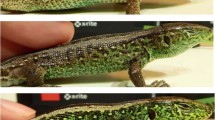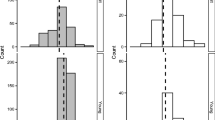Abstract
“Good genes” are genetic elements that contribute to lifetime reproductive success, regardless of an individual’s additional genotype. Their existence is debated, and most work has targeted their viability benefits to the offspring of choosy females. In the present study, we analyze a case of potential good genes effects in adult male sand lizards (Lacerta agilis). We show that males with a particular RFLP (Restriction Fragment Length Polymorphism) MHC genotype (O-males), as opposed to those that lack this genetic element (NO-males), have less ectoparasites under increasing physiological stress (indexed by baseline corticosterone level), and are not constrained by parasites at production of status coloration. Furthermore, O-males are more successful at mate acquisition and guard their partners longer. Ultimately, they have a higher genetic reproductive success as assigned by microsatellites.



Similar content being viewed by others
References
Anderholm S, Olsson M, Wapstra E, Ryberg K (2004) Fit and fat from enlarged badges: a field experiment on male sand lizards. Proc R Soc Lond B 271 [Suppl]:S142–144
Bentley PJ (1998) Comparative vertebrate endocrinology, 3rd edn. Cambridge University Press, Cambridge
Boudejamadi K, Martin O, Simon J-C, Estoup A (1999) Development and cross-species comparison of microsatellite markers in two lizard species, Lacerta vivipara and Podarcis muralis. Mol Ecol 8:518–520
Cockrem JF, Silverin B (2002) Sight of a predator can stimulate corticosterone response in the great tit (Parus major). Gen Comp Endocrinol 125:248–255
Folstad I, Karter AJ (1992) Parasites, bright males and the immunocompetence handicap. Am Nat 139:603–622
Goldsby R, Kindt TJ, Osborne BA (2002) Kuby immunology. Freeman, New York
Gullberg A, Tegelström H, Olsson M (1997) Microsatellites in the sand lizard (Lacerta agilis): description, variation, inheritance, and applicability. Biochem Genet 35:281–295
Hanssen SA, Hasselquist D, Folstad I, Erikstad KE (2004) Costs of immunity: immune responsiveness reduces survival in a vertebrate. Proc R Soc Lond B 271:925–930
Johnsen A, Andersen V, Sunding C, Lifjeld J (2000) Female blue-throats enhance offspring immunocompetence through extra-pair copulations. Nature 406:296–299
Kurtz J, Kalbe M, Aeschlimann PB, Häberli MA, Wegner KM, Reusch TBH, Milinski M (2004) Major histocompatibility complex diversity influences parasite resistance and innate immunity in sticklebacks. Proc R Soc Lond B 271:197–204
Landry C, Garant D, Duchesne P, Bernatchez L (2001) ‘Good genes as heterozygosity’: the major histocompatibility complex and mate choice in Atlantic salmon (Salmo salar). Proc R Soc Lond B 268:1279–1285
Madsen T, Olsson M, Wittzell H, Stille B, Gullberg A, Shine R, Andersson S, Tegelström H (2000) Population size and genetic diversity in sand lizard (Lacerta agilis) and adders (Vipera berus). Biol Conserv 94:257–262
Moret Y, Schmid-Haempel P (2000) Survival for immunity: the price of immune system activation for bumblebee workers. Science 290:1166–1168
Olsson M, Madsen T (2001) ‘Promiscuity’ in sand lizards and adder snakes: causes and consequences. J Hered 92:190–197
Olsson M, Shine R (1996) Does reproductive success increase with age or with size in a species with indeterminate growth?—a case study using sand lizards (Lacerta agilis). Oecologia 105:175–178
Olsson M, Wapstra E, Madsen T, Silverin B (2000) Testosterone, ticks, and travels: a test of the immunocompetence-handicap hypothesis in free-ranging lizards. Proc R Soc Lond B 267:2339–2343
Penn DJ, Potts WK (1998) MHC-disassortative mating preferences reversed by cross-fostering. Proc R Soc Lond B 265:1299–1306
Penn DJ, Potts WK (1999) The evolution of mating preferences and major histocompatibility complex genes. Am Nat 153:145–164
Reusch TBH, Haeberli A, Aeschlimann PB, Milinski M (2001) Female sticklebacks count alleles: a new strategy of sexual selection explaining MHC-polymorphism. Nature 414:300–302
Rowland-Jones SL, Dong T, Fowke KR, Kimani J, Krausa P, Newell H, Blanchard T, Ariyshi K, Oyugi J, Ngugi E, Bwayo J, MacDonald KS, McMichael AJ, Plummer FA (1998) Cell responses to multiple conserved HIV epitopes in HIV-resistant prostitutes in Nairobi. J Clin Invest 102:1758–1765
Råberg L, Grahn M, Hasselquist D, Svensson E (1998) On the adaptive significance of stress-induced immunosuppression. Proc R Soc Lond B 265:1637–1641
Silverin B (1997) The stress response and autumn dispersal behaviour in willow tits. Anim Behav 53:451–459
Silverin B, Kikuchi M, Ishii S (1999) Seasonal changes in follicle-stimulating hormone in free-living great tits. Gen Comp Endocrinol 108:366–373
Uller T, Olsson M, Madsen T (2003) Family and population effects on disease resistance in a reptile. Heredity 91:112–116
Wikelski M, Thom C (2000) Marine iguanas shrink to survive El Niño. Nature 403:37–38
Wingfield JC,Vleck CM, Moore MC (1992) Seasonal changes of the adrenocortical response to stress in birds of the Sonoran desert. J Exp Zool 264:419–428
Acknowledgements
We thank the Swedish Science Council (M.O.) for financial support and the Australian Academy of Science (E.W.), and T. Uller and W. Cooper for comments on the manuscript. This work was performed in compliance with ethics regulations at University of Gothenburg, Sweden.
Author information
Authors and Affiliations
Corresponding author
Additional information
Communicated by W. Cooper
Rights and permissions
About this article
Cite this article
Olsson, M., Madsen, T., Wapstra, E. et al. MHC, health, color, and reproductive success in sand lizards. Behav Ecol Sociobiol 58, 289–294 (2005). https://doi.org/10.1007/s00265-005-0921-y
Received:
Revised:
Accepted:
Published:
Issue Date:
DOI: https://doi.org/10.1007/s00265-005-0921-y




